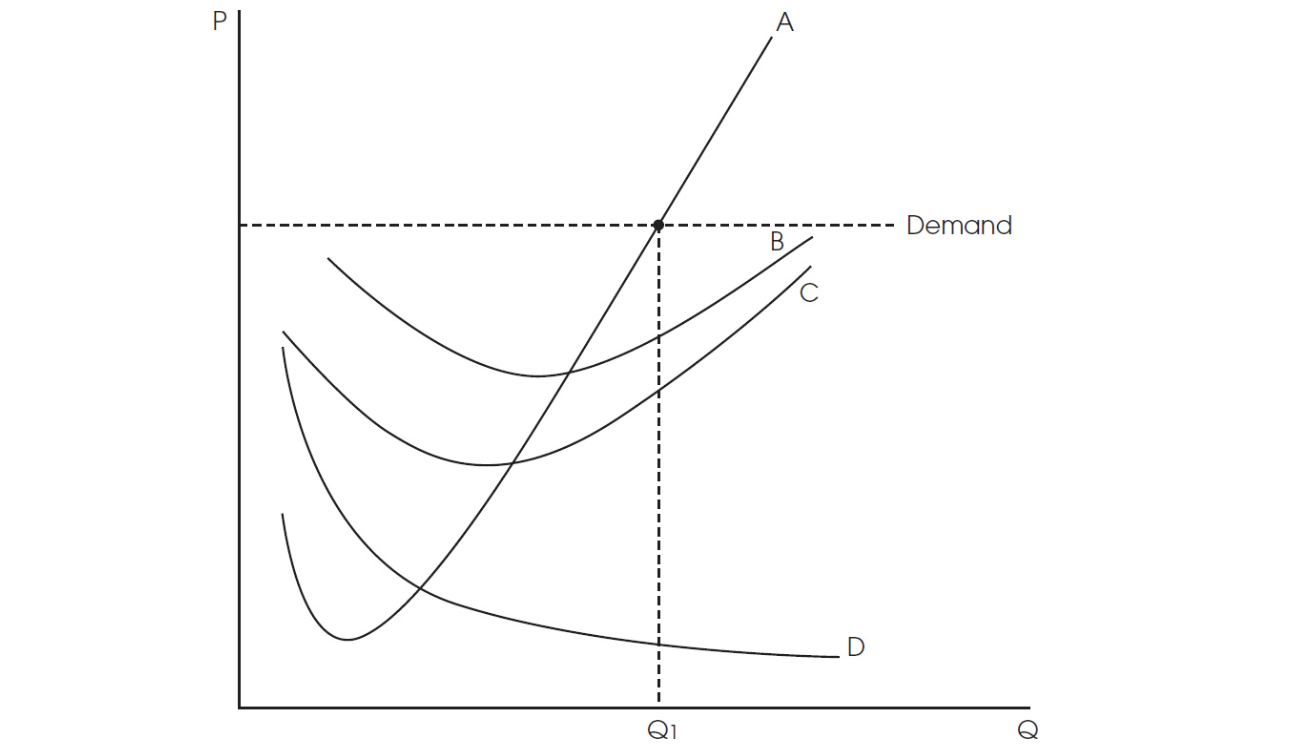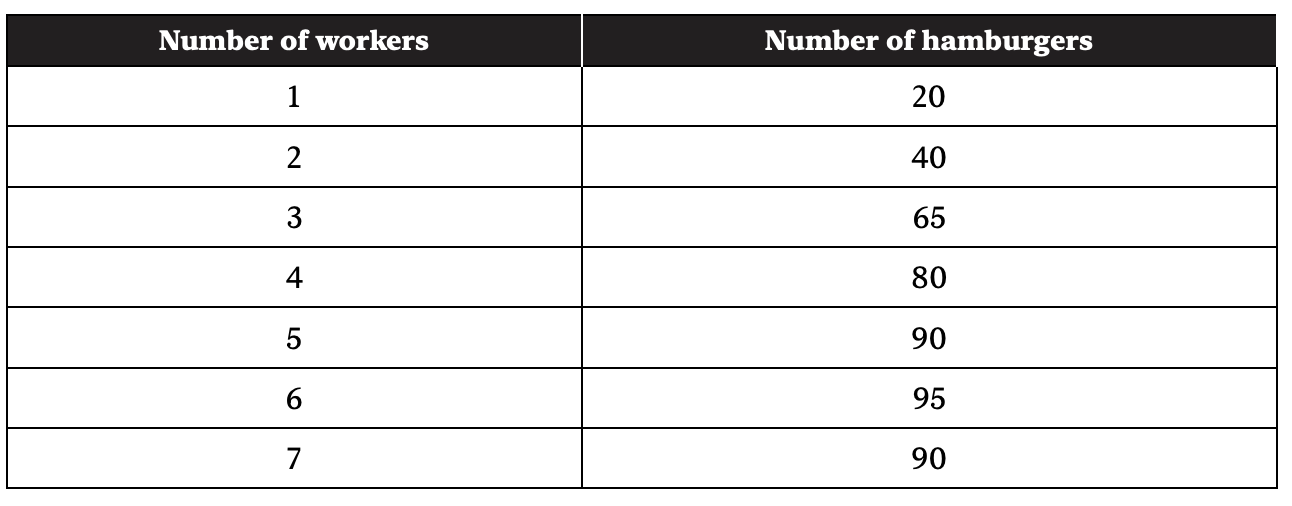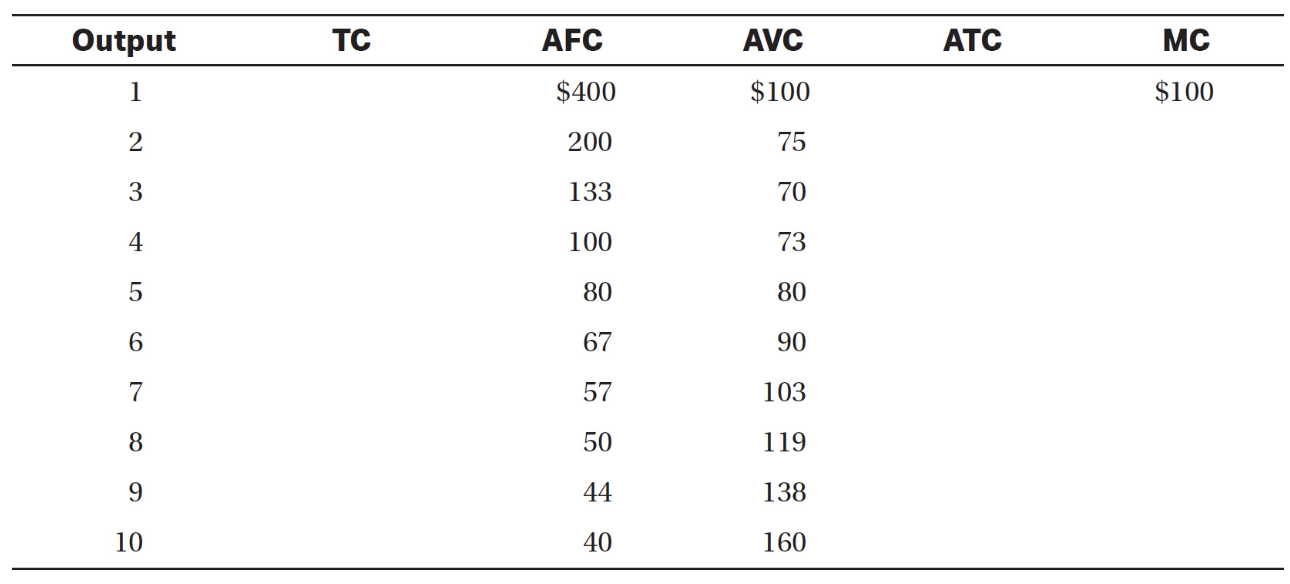AP Microeconomics/Macroeconomics Premium, 2024-Costs of Production
Multiple-Choice Review Questions
1. Which of the following is true?
(A) TC = TVC + TFC
(B) TFC = MC + ATC
(C) AVC + AFC = TC
(D) MC = TC − TFC
(E) ATC = AVC + MC
2. If a business owner has a $100,000 accounting profit and could have made exactly $60,000 in his next best business opportunity, he has earned
(A) $160,000 in economic profits.
(B) $100,000 in economic profits.
(C) $40,000 in economic profits.
(D) neither an economic profit or loss.
(E) none of the above.
3. With capital fixed at one unit with 1, 2, 3 units of labor added in equal successive units, production of the output increases from 300 (1 unit of labor) to 350 (2 units of labor) to 375 (3 units of labor). Which of the following is a correct interpretation?
(A) This is long-run increasing returns to scale.
(B) This is long-run decreasing returns to scale.
(C) This is long-run constant returns to scale.
(D) This is short-run diminishing marginal returns.
(E) This is short-run increasing marginal returns.
4. There are economies of scale when
(A) the tripling of all inputs doubles the output produced.
(B) long-run average total cost decreases as output increases.
(C) the short-run average total cost curve remains constant as output increases.
(D) the long-run average total cost curve increases as output increases.
(E) the short-run average total cost curve increases as output increases.
5. Marginal cost (MC) is equal to average variable cost (AVC) and average total cost (ATC) when
(A) marginal cost (MC) intersects AVC and ATC at their maximum points.
(B) AVC and ATC intersect MC at its maximum point.
(C) MC intersects AVC and ATC at their minimum points.
(D) AVC and ATC intersect MC at its minimum point.
(E) the economy is in the recovery phase of the business cycle.
Refer to the graph below for question 6.

6. Which cost curves do A, B, C, and D represent, in order from A to D?
(A) ATC, MC, AFC, AVC
(B) MC, AFC, AVC, ATC
(C) MC, ATC, AVC, AFC
(D) AFC, MC, ATC, AVC
(E) AFC, ATC, AVC, MC
7. Which of the following statements is true regarding the marginal cost (MC), average variable cost (AVC), and average total cost (ATC) curves?
(A) If MC is greater than ATC and AVC, then ATC and AVC must be decreasing.
(B) If MC is greater than ATC and AVC, then ATC and AVC must be increasing.
(C) If MC is increasing, then ATC and AVC must be increasing.
(D)If ATC and AVC are decreasing, MC must be decreasing as well.
(E)If AVC is increasing, then both MC and ATC must be increasing.
8. If a firm’s average total cost curve is increasing as output increases, the firm’s marginal cost must be
(A) less than average total cost.
(B) greater than average total cost.
(C) equal to average total cost.
(D) less than average variable cost but greater than average total cost.
(E) less than both variable and average total cost.
For questions 9 and 10 refer to the following table.

9. The table refers to the quantity of hamburgers that can be produced in a day. What is the marginal product of the 4th worker?
(A) 15
(B) 20
(C) 40
(D) 80
(E) 210
10. The table refers to the number quantity of hamburgers that can be produced in a day. With which worker will diminishing returns set in?
(A) 2nd
(B) 3rd
(C) 4th
(D) 5th
(E) 6th
For questions 11, 12, and 13 refer to the following table.

11. In the table, what is the average variable cost of producing 3 units of output?
(A) $8
(B) $14.6
(C) $16.6
(D) $33
(E) $44
12. In the table, what is the marginal cost of producing the 4th unit of output?
(A) $2
(B) $6
(C) $12.5
(D) $36.4
(E) $50
13. In the table, what is the total variable cost of producing the 4th unit of output?
(A) $12.5
(B) $20
(C) $30
(D) $162
(E) $182
14. If a per-unit tax is imposed on the production of wheat, which of the following shifts of cost curves is correct?
(A) There will be a downward shift of the ATC curve only, not the MC and AVC curves.
(B) There will be an upward shift of the ATC curve only, not MC and AVC.
(C) There will be an upward shift of the MC curve only, not ATC and AVC.
(D) There will be a upward shift of the MC, ATC, and AVC curves.
(E) There will be an increase in the AFC curve.
15. The vertical distance between the AVC and ATC measures
(A) marginal cost.
(B) total variable costs.
(C) revenue.
(D) total fixed cost.
(E) average fixed costs.
Free-Response Review Questions
1.
(a) Draw a graph of the AFC, AVC, ATC, and MC curves for a typical firm.
(b) Explain why the marginal cost curve intersects both the AVC and ATC at their minimum points.
2.
(a) Complete the table below.

(b) Determine what total costs (TC) would be for zero output.




